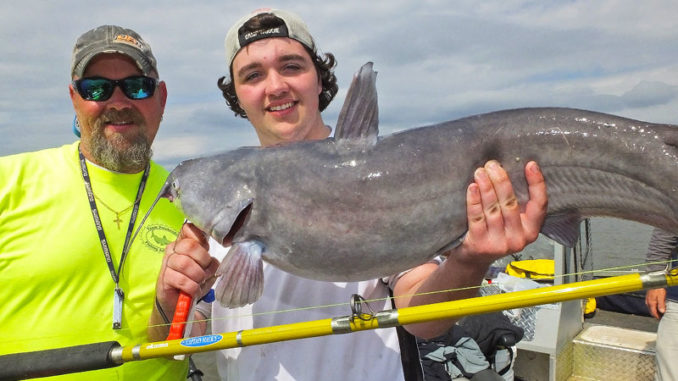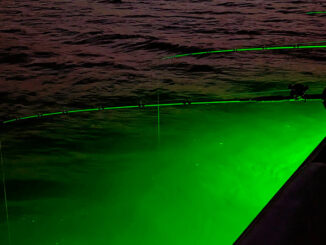
New regulation covers all lakes and rivers in South Carolina
Catfish anglers on the Santee Cooper lakes received excellent news recently when the South Carolina legislature passed a bill reinstating the original 2014 Blue Catfish law.
Gov. Henry McMaster signed it on May 17, 2021, and it went into effect on June 16. The S.C. Department of Natural Resources worked with the legislature in support of the bill.
The 2014 regulation was removed in 2018 because stipulations of a “sunset clause” were not met. The regulation automatically reverted to the previous legislation, passed in 2007.
Levi Kaczka, the SCDNR fisheries biologist in the Santee Cooper area, said SCDNR thinks this bill will ensure that the blue catfish population at Santee Cooper remains healthy for both numbers and trophy-sized blue catfish.
“The creel and size limits are the same as those previously passed in the 2014 bill, specifically, 25 blue catfish per person, per day with only two fish larger than 32 inches in that 25-fish total,” he said. “The big change is the 2014 law only affected the Santee Cooper system. But the new law applies to blue catfish state-wide.”
Regulation should help population and size of trophy fishery
Kaczka said this regulation supersedes the 2007 regulation which had no daily creel limit and a size restriction of one fish over 36 inches per person, per day.
“The 2007 regulation provided the first protection for blue catfish contributing to the trophy aspect of the fishery,” he said. “With continuing to have no bag restrictions on fish under 36 inches, though, we continued to see declines on overall numbers. Big catfish contributed a large percentage of the population. But the overall size of the population was at an all-time low. With passing of the 2014 regulations, protection for trophy fish remained, while introducing protection for the population at any size.”
Kaczka said the goal of the 2014 regulation was to increase population size through a daily creel limit, while still providing opportunity for individuals to harvest a fair number of blue catfish.
“We immediately saw increases in both overall numbers and large blue catfish in excess of 32 inches,” he said. “Our surveys and biological assessment of the blue catfish population indicates that trend has continued since enactment of that regulation.”
Kaczka said harvest is an important aspect of any fishery, especially one where a trophy component is desired. But in the years after the 2007 regulations, the overall harvest rate in the Santee Cooper system was unsustainable for providing a fishery that was equally focused on size and numbers of fish.
Several needs are met with new regulation
“The 25 fish per day and two over 32 inches regulation was such a success, in my mind, because it solved several needs for the fishery,” he said. “First, it provided anglers the opportunity for high daily harvest rates and the opportunity for harvesting multiple trophy fish per day. Most important, the third reason, is the regulation provided the first two opportunities while protecting the blue catfish population sufficiently to not simply sustain, but increase in both size and numbers.”
Kaczka said the impact of reverting to the 2007 regulations for the past three years have been minimal.
“Winter gill-netting data since reverting to the former law hasn’t documented any decline,” he said. “The last two years of data show that numbers of large catfish are at an all-time high. And overall weight of winter gill-net blue catfish collections is at an all-time high. Plus, overall numbers are second only to those witnessed throughout the 1990s when numbers were strong but fish averaged somewhat smaller in size.
Kaczka said his assessment for no declines is two-fold
“First, although regulations reverted to no creel limit for fish less than 36 inches, the harvest-oriented anglers in Santee Cooper continued to be mainly comprised of fishermen harvesting less than 25 fish per day,” he said. “Second, with blue catfish living up to 30 years on Santee Cooper, they’re less likely to show major population-level effects after a relatively short period of regulation change.”
Kaczka said SCDNR worked closely with the legislature to get regulations reinstated, because scientific data demonstrated that the 2014 regulation was a success both in terms of the data and anecdotally among most user groups, including recreational anglers and guides.
“Having science and angler opinion agree is a welcome occurrence. So from an agency standpoint, it made sense to support these regs being reinstated,” he said.
Kaczka said the Santee Cooper Country tourism board was a strong advocate of the 2014 law and supported and worked diligently to get the regulation reintroduced.
Kaczka said the new law impacts only blue catfish, and no sunset clause was included in the 2021 bill. The SCDNR is required to report to the legislature on the status of the fishery by Jan. 1, 2025.





Be the first to comment